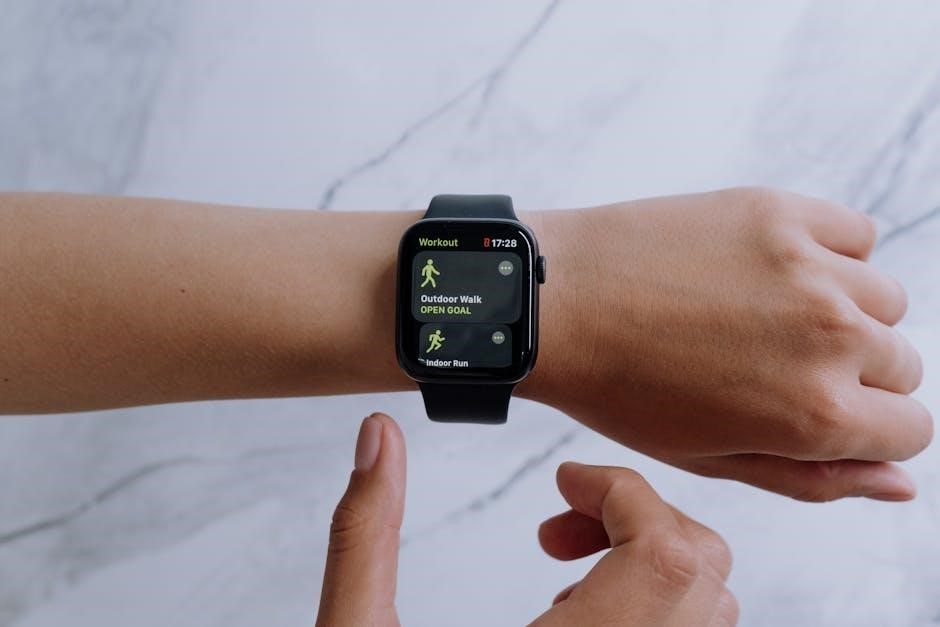Wrist exercises after a fracture are crucial for restoring mobility, strength, and function. Regular, gentle movements help prevent stiffness, improve range of motion, and promote healing. Consistency is key to a successful recovery.
Importance of Rehabilitation Exercises
Rehabilitation exercises are vital for restoring wrist function after a fracture. They improve mobility, reduce stiffness, and enhance circulation. Consistent practice helps regain strength and flexibility, crucial for daily activities. These exercises also prevent long-term complications and speed up recovery, allowing patients to return to normal life sooner. Regular and gentle movements are essential for optimal healing, reducing swelling, and promoting overall recovery. This structured approach ensures a faster and more effective return to independence and mobility. By following a tailored exercise program, individuals can achieve the best possible outcomes and minimize lasting effects from the injury.
Understanding the Healing Process
The healing process after a wrist fracture involves several stages, starting with inflammation, followed by soft callus formation, and ending with hard callus and bone remodeling. During this time, exercises play a critical role in supporting recovery. Gentle movements improve circulation, reduce stiffness, and prevent complications like joint contractures. Understanding this process helps patients appreciate the importance of gradual and controlled exercises. Proper healing ensures the wrist regains its strength and mobility, allowing individuals to return to daily activities and sports. Patience and adherence to a structured exercise plan are essential for optimal recovery and long-term functionality.
Types of Wrist Fractures
Wrist fractures include distal radius fractures, ulna fractures, and comminuted fractures. Each type varies in severity and location, requiring tailored rehabilitation approaches for optimal recovery.
Distal Radius Fracture
A distal radius fracture occurs when the radius bone near the wrist breaks. It’s a common injury, often caused by falls or trauma. Treatment may involve casting or surgery, depending on the severity. Rehabilitation focuses on restoring wrist motion and strength. Gentle exercises, like wrist flexion and extension, are typically recommended. These exercises help improve mobility and prevent stiffness. Consistency is key, with exercises performed multiple times daily. Proper guidance from a healthcare professional ensures a safe and effective recovery, helping patients regain full wrist function and return to daily activities.
Ulna Fracture
An ulna fracture involves a break in the ulna bone, one of the two forearm bones, often occurring near the wrist. It may happen alone or alongside a distal radius fracture. Rehabilitation focuses on restoring wrist and forearm mobility. Exercises like wrist rotation and forearm supination are commonly recommended. These movements help improve flexibility and strength. Gentle, controlled exercises are essential to avoid further injury. Recovery time varies, but consistent practice ensures optimal healing. Patients should follow a structured exercise plan under professional guidance to regain full function and reduce stiffness in the affected area, promoting a smooth return to normal activities.
Comminuted Fractures
A comminuted fracture occurs when the bone breaks into multiple fragments, complicating the healing process. In the wrist, this often involves the distal radius or ulna. Such fractures may require surgery to stabilize the bone with plates or screws. Post-operative exercises focus on gentle movements to maintain joint mobility without disrupting the repair. Early exercises include finger bends and wrist rotations, progressing to strengthening as healing advances. Patients must avoid overexertion to prevent fragment displacement. Rehabilitation is gradual, with close monitoring by healthcare professionals to ensure proper alignment and recovery. Consistent, controlled exercises are vital for achieving optimal wrist function and minimizing long-term stiffness.
When to Start Exercises
Exercises should begin as soon as your doctor approves, typically after the initial healing phase, to restore wrist mobility and strength gradually and safely.
Immediate Post-Fracture Care
Immediately after a wrist fracture, prioritize immobilization and pain management; Elevate the wrist to reduce swelling and apply ice packs for 15-20 minutes, several times a day. Avoid moving the injured wrist and keep it in a splint or cast as directed. Pain relief can be managed with over-the-counter medications, but always follow your doctor’s advice. Proper wound care is essential if surgery was performed, ensuring the area remains clean and dry to prevent infection. Early mobilization of fingers and elbow is encouraged to maintain joint mobility and circulation, even while the wrist is immobilized. Monitoring for numbness or tingling is crucial to address any complications promptly.
Exercises While in a Cast
Exercises while in a cast focus on maintaining mobility in unaffected joints and promoting circulation. Gentle finger bends and straightens, elbow flexion, and shoulder rolls are recommended. These movements help prevent stiffness and improve blood flow. Avoid putting pressure on the cast or moving the fractured wrist. Perform exercises 10-15 times every 1-2 hours to keep joints mobile. These exercises are crucial for overall arm function and preparation for post-cast rehabilitation. Consistency is key to ensure proper healing and maintain muscle activity without overexerting the injured wrist.
Post-Cast Removal Exercises
Post-cast removal exercises focus on restoring wrist mobility and strength. Gentle stretching, such as wrist circles and finger-to-floor stretches, can improve range of motion. Strengthening exercises, like using light resistance bands or weights, help rebuild muscle tone. Start with 10-15 repetitions of each exercise, 3-5 times daily. Gradually increase intensity as comfort allows. Wrist flexion and extension exercises, along with supination and pronation, are essential. Soaking the wrist in warm water before exercises can enhance flexibility. Consistency is key to regain full function and reduce stiffness. Always consult a therapist to tailor exercises to your recovery progress and ensure proper healing.

Stretching Exercises for Wrist Mobility
Stretching exercises improve wrist flexibility and range of motion. Wrist flexion, extension, radial/ulnar deviation, and supination/pronation are essential. Soak the wrist in warm water before exercises to enhance flexibility and reduce stiffness. Perform each stretch gently, holding for 20-30 seconds, and repeat 10 times, 5 times daily. Consistency helps regain mobility and strength, promoting a full recovery. Always prioritize comfort and avoid pain during exercises.
Wrist Flexion Exercise
Start with your forearm resting on a flat surface, palm facing up. Slowly bend your wrist upward, lifting your hand toward your forearm until a gentle stretch is felt. Hold for 5 seconds, then lower your hand back down. Repeat this motion 10 times, 3-5 times daily. To add resistance, hold a light weight in your hand during the exercise. This strengthens the flexor muscles and improves wrist mobility. Ensure movements are smooth and controlled, avoiding sharp pain. Progress gradually by increasing the weight or repetitions as comfort allows. Consistency in this exercise aids in restoring functional wrist movement post-fracture.
Wrist Extension Exercise
Begin with your forearm resting on a flat surface, palm facing down. Slowly lift your hand upward, bending your wrist as far as possible without causing pain. Hold for 5 seconds, then gently lower your hand back to the starting position. Repeat this exercise 10 times, performing 3-5 sets daily. To enhance strength, use a light weight or resistance band. This exercise targets the extensor muscles, improving wrist mobility and reducing stiffness. Perform the movement smoothly, avoiding jerky motions. Gradually increase the number of repetitions or resistance as your wrist becomes stronger. Consistency in this exercise helps restore functional wrist extension post-fracture.
Radial and Ulnar Deviation
Radial and ulnar deviation exercises help restore sideways wrist movement. Sit with your forearm resting on a table, palm facing down. Slowly tilt your wrist toward your thumb (radial deviation), then toward your little finger (ulnar deviation). Move only your wrist, keeping your forearm still. Repeat each direction 10 times, 3-5 times daily. These exercises improve flexibility and reduce stiffness. Start gently, increasing range as comfort allows. Performing these movements regularly enhances functional wrist mobility, crucial for daily activities like gripping and turning objects. Avoid forcing your wrist beyond a painful point to prevent further injury.
Supination and Pronation
Supination and pronation exercises focus on forearm and wrist rotation. Sit with your elbow bent at 90 degrees, palm facing down (pronation). Slowly turn your palm upward (supination) without moving your elbow. Hold for 5 seconds, then return. Repeat 10-15 times, 3-5 times daily. These movements improve forearm rotation and wrist flexibility. Start with gentle rotations, gradually increasing range. Avoid pain during exercises. This enhances functional movements like turning doorknobs or using utensils. Consistency is key for optimal recovery and restoring natural wrist and forearm mobility, essential for daily activities and strength.

Strengthening Exercises
Strengthening exercises after a wrist fracture focus on rebuilding muscle strength and stability. Use light weights or resistance bands to gradually improve wrist and forearm power, aiding recovery.
Wrist Extension with Light Weights
Wrist extension with light weights is a key strengthening exercise after a fracture. Sit with your forearm on a table, palm down, and hold a light weight. Slowly lift your wrist, keeping your forearm still, then lower it back. Repeat 10-15 times, 3-5 times daily. Start with a small weight and gradually increase as strength improves. This exercise targets the extensor muscles, helping restore wrist movement and power. Proper form is essential to avoid strain. If pain occurs, reduce the weight or consult your therapist; Consistency is vital for optimal recovery and regaining functional wrist strength.
Wrist Flexion with Resistance
Wrist flexion with resistance strengthens the flexor muscles, improving wrist mobility and grip strength. Sit with your forearm on a table, palm up, and hold a light weight or resistance band. Slowly bend your wrist upward, then lower it back. Repeat 10-15 times, 3-5 times daily. Start with minimal resistance and gradually increase as strength improves. This exercise helps restore functional movement and reduces stiffness. Proper form is essential to avoid strain. If pain occurs, stop the exercise and consult your therapist. Consistency in this exercise is key to regaining wrist flexion and overall hand function after a fracture.
Grip Strengthening
Grip Strengthening
Grip strengthening is essential for regaining wrist function and improving daily activities. Use a squeezable ball or towel to perform this exercise. Sit with your hand resting and gently squeeze the object for 5-10 seconds, then release. Repeat 10-15 times, 3-5 times daily. You can also use a resistance band by wrapping it around your fingers and pulling gently. Start with light resistance and gradually increase as grip strength improves. This exercise targets the muscles in your hand and forearm, enhancing your ability to grip objects firmly. Consistency and patience are key to achieving meaningful progress in grip strength after a wrist fracture;
Resistance Band Exercises
Resistance band exercises are effective for improving wrist strength and flexibility after a fracture. Loop the band around your hand or secure it to a stable object. Perform wrist extensions by pulling the band gently, holding for 5 seconds, and releasing. Repeat 10-15 times, 3-5 times daily. You can also use the band for flexion by bending your wrist downward. Start with light resistance and gradually increase as strength improves. These exercises target the forearm and wrist muscles, enhancing grip and movement. Consistency is key to achieving noticeable progress. Always warm up before starting and avoid overexertion to prevent discomfort.
Range of Motion Exercises
Range of motion exercises improve wrist flexibility and mobility post-fracture. Gentle movements like wrist circles, finger bends, and extensions help restore joint function and promote healing naturally.
Passive Wrist Extension
Passive wrist extension involves gently moving the wrist without active muscle engagement. Sit with forearm resting, palm down. Use the unaffected hand to slowly lift the wrist back, holding 5-10 seconds. Repeat 10 times, 3-5 times daily. This exercise enhances flexibility, reduces stiffness, and promotes healing. Avoid pain; gentle stretching is key. Regular practice helps restore wrist extension, crucial for daily activities. Consistency aids recovery, improving range of motion gradually. Start with minimal movement, increasing as comfort allows, ensuring proper alignment to avoid strain. This exercise is often recommended early in rehabilitation to maintain joint mobility without overexertion.
Active Wrist Flexion
Active wrist flexion involves bending the wrist downward, palm toward the forearm. Sit comfortably, forearm resting on thigh, palm facing up. Slowly lower wrist toward floor, then return to neutral. Repeat 10 times, 3-5 times daily. This exercise strengthens flexor muscles, improves range of motion, and enhances functional ability. Start gently, gradually increasing depth as comfort allows. Avoid pain; mild stretching is acceptable. Consistency helps restore wrist movement, crucial for daily activities. Perform smoothly, maintaining control throughout the motion. This exercise is essential for regaining wrist flexibility and strength post-fracture, promoting independence in tasks like gripping and lifting.
Wrist Circles
Wrist circles are a simple yet effective exercise to improve flexibility and reduce stiffness. Sit or stand with forearm supported, wrist off the edge. Move wrist in small circles, first clockwise, then counterclockwise. Start with 5-10 circles in each direction, gradually increasing as comfort allows; Perform 3-5 times daily. This exercise enhances range of motion, promotes healing, and prevents long-term stiffness. Keep movements slow and controlled, avoiding jerky actions. As flexibility improves, increase the size of circles. Consistency is key to restoring wrist mobility and ensuring a full recovery. Regular practice helps maintain joint health and improves functional ability post-fracture.
Finger Bending and Straightening
Finger bending and straightening exercises target the muscles and tendons connected to the wrist, enhancing dexterity and strength. Sit with forearm supported, wrist neutral. Slowly bend fingers down toward palm, then straighten fully. Repeat 10-15 times, 3-5 times daily. This exercise improves grip strength, reduces stiffness, and restores functional movement. Gentle resistance, using light weights or bands, can be added as strength increases. Consistency aids in regaining hand and wrist coordination, essential for daily activities. Regular practice prevents long-term limitations and supports overall recovery. Proper form ensures effectiveness and avoids strain.

Exercise Frequency and Duration
Perform exercises 10 times per session, 5 times daily, to enhance wrist mobility and strength. Consistency ensures progress, with each session lasting 10-15 minutes for optimal recovery.
Recommended Daily Routine
A recommended daily routine involves performing wrist exercises 10 times per session, 5 times a day, to enhance mobility and strength. Start with gentle warm-ups, such as wrist circles, to prepare the joint. In the morning, focus on range-of-motion exercises like wrist flexion and extension. Midday, incorporate grip strengthening and radial-ulnar deviation exercises. In the evening, repeat the range-of-motion exercises and add resistance band workouts if advised. Before bed, perform gentle stretching to maintain flexibility. Consistency is key, and each session should last 10-15 minutes. Adjust the routine based on comfort and progress, ensuring not to overexert the wrist.
Duration of Each Exercise
Each wrist exercise should be performed for a specific duration to ensure effectiveness without overexertion. Stretching exercises, such as wrist flexion and extension, should be held for 20-30 seconds and repeated 10 times. Strengthening exercises, like wrist extensions with light weights, should be done for 10-15 repetitions, while grip strengthening can be performed for 5-10 minutes. Range-of-motion exercises, such as wrist circles, should be done for 5-10 minutes per session. Each exercise session should last 10-15 minutes, with rest periods in between to avoid fatigue. Gradually increase the duration as the wrist heals and strength improves. Consistency is essential for optimal recovery.
Progressing the Intensity
As healing progresses, gradually increase the intensity of wrist exercises to build strength and improve mobility. Start with light resistance, such as using a light dumbbell or resistance band, and slowly increase the weight or tension. After 4-6 weeks, when pain subsides, introduce dynamic movements like wrist circles with resistance. Avoid sudden increases in intensity to prevent re-injury. Progressing too quickly can lead to setbacks, so always prioritize comfort and stability. Consult your healthcare provider or therapist to ensure a safe and effective progression plan tailored to your recovery stage. Consistent, gradual increases in intensity will help restore full wrist function over time.
Recovery Timeline
Wrist fracture recovery typically spans several months, with initial healing in 6-8 weeks. Full strength and mobility may take 6-12 months, varying by patient and fracture severity.
Initial Recovery Phase
The initial recovery phase after a wrist fracture focuses on immobilization, pain management, and swelling reduction. Typically lasting 2-4 weeks, this period involves wearing a cast or splint to protect the fracture. During this time, patients are advised to avoid putting weight on the wrist and to elevate the arm to reduce swelling. Gentle finger exercises may be recommended to maintain mobility in the hand and forearm. Pain management often includes ice therapy and prescribed medication. It’s crucial to follow medical guidance to ensure proper healing and prevent complications. This phase lays the foundation for successful rehabilitation and future mobility.
Intermediate Phase
The intermediate phase begins once the cast is removed, typically around 4-6 weeks post-fracture. This stage focuses on restoring wrist mobility through controlled exercises. Patients often start with passive range-of-motion exercises, where a therapist or caregiver gently moves the wrist. Active exercises, such as wrist flexion and extension, are gradually introduced to strengthen muscles. Resistance bands and light weights may be incorporated to build strength. It’s important to perform these exercises regularly, as directed by a healthcare provider, to avoid stiffness and promote healing. Pain should be monitored, and exercises adjusted to avoid overexertion. This phase is critical for regaining functional movement and preparing for more advanced activities.
Advanced Phase
The advanced phase typically begins 3-6 months after the fracture, once significant healing has occurred. During this stage, exercises focus on strengthening the wrist and restoring full functionality. Patients often progress to resistance band exercises, light weight lifting, and grip strengtheners to build endurance. Activities that mimic daily tasks or sports-specific movements are introduced to enhance coordination and dexterity. It’s crucial to maintain proper form to avoid re-injury. The goal is to achieve near-normal wrist function, allowing a return to pre-injury activities. Consistency and gradual progression are emphasized to ensure a full recovery and prevent long-term limitations.
Additional Tips for Recovery
Warm up before exercises, maintain proper posture, and monitor pain levels to ensure a safe and effective recovery. Listen to your body and adjust accordingly.
Warm-Up Before Exercises
Warming up before wrist exercises is essential to prepare the muscles and joints, reducing stiffness and improving circulation. Start by soaking your hand and wrist in warm water for 10–15 minutes. Gentle movements, such as finger bending and straightening, can help increase flexibility. Wrist circles, performed slowly in both clockwise and counterclockwise directions, are also effective. These activities enhance blood flow and reduce the risk of pain during exercises. A proper warm-up ensures a smoother transition into rehabilitation routines, making the exercises more effective and comfortable; Consistency in this routine will support overall recovery and wrist mobility.
Proper Posture During Exercises
Correct posture during wrist exercises is vital to ensure safety and effectiveness. When performing exercises, keep your forearm on a flat surface, such as a table, with your elbow bent at 90 degrees. This position supports your arm and aligns your wrist in a neutral position, reducing strain. Avoid slouching or leaning forward, as this can lead to improper movement and discomfort. Maintaining proper posture helps target the right muscles, prevents fatigue, and minimizes the risk of further injury. By keeping your body aligned and your wrist stable, you can maximize the benefits of your rehabilitation routine and promote a faster recovery.
Monitoring Pain Levels
Monitoring pain levels during wrist exercises is essential to avoid overexertion and prevent further injury. Pain is a natural part of the healing process, but sharp or increasing pain may indicate that an exercise is being done incorrectly or too aggressively. It’s important to stop and rest if pain becomes unbearable. Mild discomfort is usually manageable and can be alleviated by adjusting the intensity or taking regular breaks. Keeping a pain journal can help track progress and identify patterns, ensuring exercises are performed safely and effectively; Always consult a healthcare professional if pain persists or worsens, as this could signal a need to modify the rehabilitation plan;

Safety Precautions
Safety precautions ensure exercises are performed correctly to avoid injury. Use proper equipment, avoid overexertion, and monitor pain levels. Stop if pain increases and consult a professional if needed.
Avoiding Overexertion
Avoiding overexertion is essential to prevent further injury and promote healing. Start with gentle exercises and gradually increase intensity as strength and mobility improve. Stop if pain increases or sharp discomfort occurs. Overexertion can lead to setbacks, delaying recovery. Listen to your body and only perform exercises within a comfortable range. If unsure, consult a healthcare provider or physical therapist for guidance. Proper progression ensures a safe and effective rehabilitation process.
Using Proper Equipment
Using proper equipment is vital for safe and effective wrist rehabilitation. Light weights, resistance bands, and therapy tools like putty or squeezes can aid in strengthening without causing strain. Ensure all equipment is recommended by a healthcare professional or physical therapist to suit your specific fracture type and recovery stage. Avoid using heavy or unsuitable tools that could lead to reinjury. Proper equipment helps maintain alignment and prevents unnecessary stress on the healing wrist, promoting a safer and more efficient recovery process.
When to Seek Medical Advice
Seek medical advice immediately if you experience increased pain, swelling, or numbness in your wrist or hand. If you notice any signs of infection, such as redness or warmth around the fracture site, contact your healthcare provider. Additionally, consult your doctor if you are unable to perform prescribed exercises or if your wrist shows no improvement in mobility or strength. Persistent pain or limited movement despite consistent effort may indicate complications. Always consult your healthcare professional before starting or modifying your exercise routine to ensure safety and effectiveness in your recovery process.
Comments